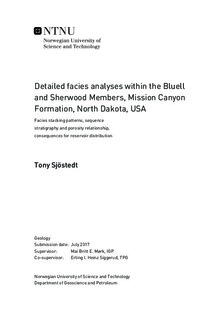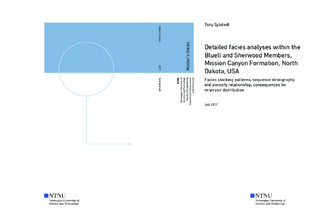| dc.description.abstract | Detailed core analysis from seven wells with cores cut within the overall carbonate succession that makes up the Bluell and Sherwood Members of the Mission Canyon Formation located in Renville County, North Dakota, resulted in the identification of eleven depositional facies. These facies that reflect a range in depositional conditions from inner to back ramp, that is shallow fair-weather to uppermost intertidal and supratidal conditions. Systematic core analysis using a highly detailed digital template for recording of sedimentological details enabled not only a high degree of uniformity in facies identification but also detailed vertical facies stacking patterns for each well. The facies stacking patterns revealed that these shallow marine to marginal marine successions consists of thin (decimetre-scale) beds with rapid upward shifts in facies, reflecting the very shallow sea-level at the time of deposition. While this work enabled detailed facies mapping to be undertaken the seemingly random porosity distribution represented a major challenge in oil exploration and production within the eastern Flank of the Williston Basin.
The core analysis revealed that to preserve porosity (and thus permeability) was dependent on a combination of depositional, intergranular porosity and secondary dissolution, moldic and vuggy porosity, only observed within the pack- to grainstone facies reflecting shallow marine conditions. Systematic core analysis furthermore established a relationship between sediment grain-size, sorting (maturity), development of moldic to vuggy porosity and degree of cementation. Whereby the former is related to location within the depositional processes and the subtle variations within the depositional system. The later to the combination of higher interparticle porosity that together with the secondary porosity, result in that cementation is not sufficient to block all pore-connections. Thereby creating the active reservoir intervals observed in core and from production. However, the limited thickness of these beds (some 40-60 cm) also explains the challenge in prediction location of active reservoir as experienced in the past.
Careful log to core correlation was also undertaken and revealed that for most parts that conventional logs does not have the necessary resolution to predict locations of active reservoir as observed from the core analysis. Consequently, there has been established a relationship between facies types and facies distribution and the development of porosity and hence, active reservoir enabling logical prediction of more producing reservoir within the Mission Canyon Formation along the eastern Flank of the Williston Basin
This illustrates the importance of recognition from detailed description of facies, related to the depositional processes and the subtle variations in the depositional system that enables a better understanding and that allows to logically predict the location of best possible and well- sorted packstone and grainstone reservoirs in time and space. This becomes increasingly more significant for finding new potential targets in rapidly depleting and heterogeneous reservoirs, such as the Mission Canyon Formation. | |

